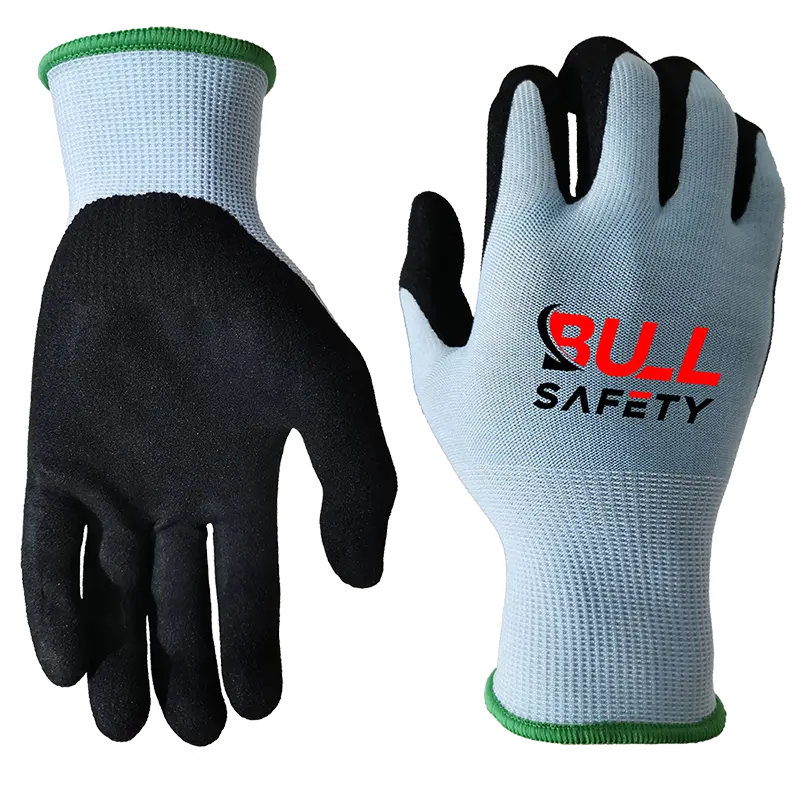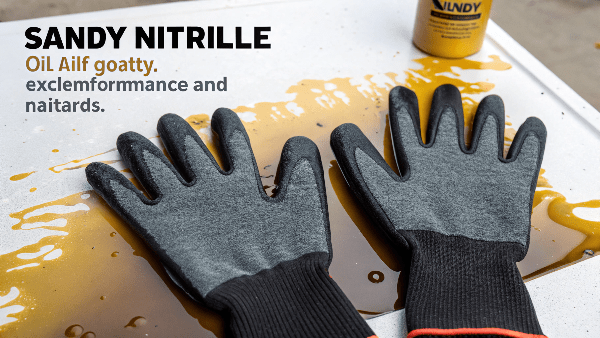
I manufacture nitrile-coated gloves1 in my factory, and I often get asked about sandy nitrile coatings2. Workers want to know what makes them different and whether they are the best option for grip and durability3.
Sandy nitrile gloves have a textured nitrile coating that provides a strong grip, abrasion resistance, and durability—making them ideal for rough, oily, or high-friction work environments.
These gloves are widely used in construction, automotive, metal handling, and oil industries. Below, I’ll share what I’ve learned from years of testing and producing these gloves.
What Are Sandy Nitrile Gloves?
I get this question a lot. Workers want to know how sandy nitrile4 is different from other coatings.
Sandy nitrile gloves are work gloves coated with nitrile that has a sand-like, textured finish. This rough surface enhances grip, abrasion resistance, and durability, making them ideal for handling oily, wet, or rough materials.
I often recommend them because the coating prevents slippage5 and improves performance in automotive, construction, and industrial tasks where grip matters.
What Are Nitrile-Coated Gloves?
I manufacture several types of nitrile-coated gloves, and many people ask how they compare to other gloves.
Nitrile-coated gloves are work gloves with a synthetic rubber coating that offers excellent resistance to oils, chemicals, and abrasions. They provide superior durability and grip compared to latex or PU-coated gloves, especially in industrial and high-risk environments.
Types of Nitrile Coatings I Make
| Coating Type | Features & Benefits |
|---|---|
| Smooth Nitrile | Offers good dexterity and flexibility but has less grip. |
| Foam Nitrile | Absorbs small amounts of liquid and improves grip in wet conditions. |
| Sandy Nitrile | Rough-textured, enhances grip and durability in oily and dry conditions. |
From my experience, sandy nitrile6 provides the best balance of grip and wear resistance for heavy-duty applications.
Can Sandy Nitrile Gloves Reach Abrasion Resistance Level 4?
Customers often ask if sandy nitrile can achieve the highest abrasion resistance7.
Yes, sandy nitrile gloves can reach Level 4 abrasion resistance according to the EN 388 standard. This level indicates they can endure up to 8,000 abrasion cycles, making them ideal for heavy-duty tasks and harsh working conditions.
Understanding EN 388 Abrasion Levels
| Abrasion Level | Cycles Required | Protection Level |
|---|---|---|
| 1 | 100 | Low |
| 2 | 500 | Moderate |
| 3 | 2000 | High |
| 4 | 8000 | Very High |
From what I’ve seen, sandy nitrile gloves last longer than foam or smooth nitrile when handling rough materials, making them perfect for metalwork, construction, and machinery jobs.
Where Are Sandy Nitrile Gloves Used?
I’ve supplied sandy nitrile gloves to many industries, and these are the ones that benefit the most.
Sandy nitrile gloves are commonly used in industries like automotive, construction, metal fabrication, and oil and gas. Their textured coating provides strong grip, high abrasion resistance, and durability, making them ideal for handling rough or oily materials in demanding work environments.
Industries I Serve with Sandy Nitrile Gloves
- Automotive – Mechanics need gloves that handle greasy, slippery parts.
- Construction – Workers use them for gripping rough surfaces like bricks and wood.
- Metal Fabrication – The gloves protect hands from sharp edges and abrasions.
- Oil & Gas – The textured coating prevents tools from slipping in oily conditions.
Designed for Jobs Where Grip and Durability Matter
If a worker needs both grip and long-lasting durability, sandy nitrile gloves are my top recommendation.
Are Sandy Nitrile Gloves Good for Oil?

Since I test my gloves in oily environments, I know which coatings work best.
Yes, sandy nitrile gloves are ideal for oily conditions. Their textured surface enhances grip on slippery materials, while the nitrile coating resists oil penetration, ensuring durability and control in wet or greasy work environments.
Why I Recommend Sandy Nitrile for Oil Handling
Sandy nitrile gloves are highly recommended for oil handling because their rough coating enhances grip on greasy parts, while the nitrile layer resists oil penetration to keep hands dry and protected. These gloves are ideal for mechanics, oil refineries, and other industrial applications where oil exposure is common.
From my experience, workers in oil-heavy jobs prefer sandy nitrile over smooth or foam coatings because of its long-lasting grip.
Conclusion
After years of testing and manufacturing work gloves, I strongly believe that sandy nitrile gloves are the best choice for workers who need durability, grip, and abrasion resistance.
✅ Best for gripping oily, rough, or heavy materials.
✅ Durable enough to handle high-friction tasks without wearing out.
✅ Provides Level 4 abrasion resistance for tough jobs.
If you need a reliable, long-lasting work glove, I highly recommend sandy nitrile gloves. Feel free to reach out if you need help choosing the right glove for your job!
Footnotes
-
Explore this link to understand the advantages of nitrile-coated gloves for various applications, enhancing your knowledge on their use. ↩
-
Discover the unique features of sandy nitrile coatings and how they improve grip and durability in demanding environments. ↩
-
Learn about the top glove options for grip and durability, ensuring you choose the right protection for your work needs. ↩
-
Explore the unique advantages of sandy nitrile gloves for enhanced grip and durability in challenging environments. ↩
-
Learn how specialized coatings can enhance grip and safety in various tasks, making your work more efficient. ↩
-
Discover the unique features of sandy nitrile gloves, known for their superior grip and durability in challenging conditions. ↩
-
Learn about abrasion resistance levels and why Level 4 is crucial for selecting gloves for heavy-duty tasks. ↩



